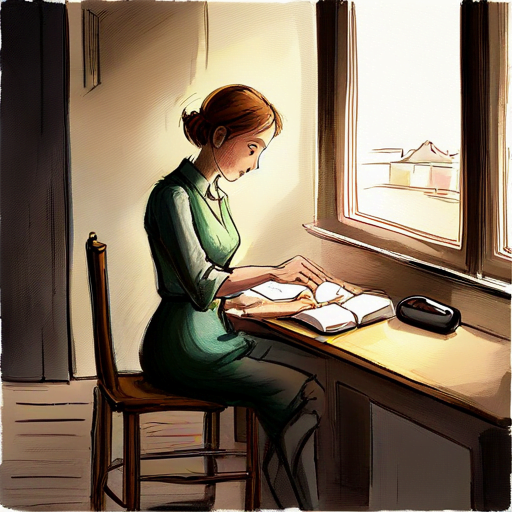Do you struggle to understand the underlying emotions in a piece of literature? Tone and mood play a pivotal role in evoking emotions and setting the atmosphere of a story. To truly experience the depth of a literary work, you need to be able to identify and analyze the sensory details that contribute to the tone and mood.
In this article, we will guide you through the process of using sensory details to determine tone and mood, so you can enrich your reading experience and appreciate the author’s intentions.
First, let’s clarify what tone and mood mean in literature. The tone refers to the author’s attitude towards the subject matter, which can range from serious to humorous, formal to informal, or pessimistic to optimistic. The mood, on the other hand, is the emotional atmosphere that the author creates for the reader, which can be eerie, suspenseful, romantic, or nostalgic.
By understanding these concepts and identifying the sensory details that contribute to them, you can gain a deeper understanding of the author’s intentions and the message they are conveying. So, let’s dive into the world of sensory details and tone and mood analysis!
Table of Contents
Understanding Tone and Mood in Literature

To truly grasp the emotional ambiance of a literary work, it’s imperative that you possess a keen awareness of the subtle nuances that the author employs to convey the underlying attitude and atmosphere of the piece.
This is where tone and mood come into play. The tone of a piece refers to the author’s attitude towards the subject matter, while the mood is the emotional atmosphere created by the words on the page.
Sensory details, such as descriptions of sights, sounds, smells, and textures, can be used to effectively convey tone and mood. By paying attention to these details, you can gain a deeper understanding of the underlying emotions and attitudes that the author is trying to convey.
Identifying Sensory Details

Let’s get a feel for the emotional atmosphere by pinpointing the physical sensations conveyed through language. When reading a piece of literature, pay attention to the sensory details used by the author. These details can include descriptions of sight, sound, touch, taste, and smell.
By identifying these details, you can better understand the tone and mood of the piece. For example, if the author describes a dark and gloomy setting, with the sound of rain tapping against the window, you can infer that the tone may be sad or melancholic. On the other hand, if the author describes a sunny day with the smell of freshly cut grass, the tone may be more uplifting and optimistic.
Sensory details add depth and richness to the writing, and can greatly enhance your understanding of the tone and mood.
Analyzing Sensory Details for Tone and Mood

You can really feel the emotions of a piece of literature by paying attention to the physical sensations described by the author, giving you a better understanding of the atmosphere they create.
Analyzing sensory details for tone and mood is a crucial step in understanding a text. Tone is the author’s attitude towards the subject matter, while mood is the emotional atmosphere created by the text.
By examining the sensory details, such as sight, sound, smell, taste, and touch, you can uncover the underlying emotions and feelings that the author is trying to convey. For example, if a character is described as feeling a cold, damp breeze on their skin, this could suggest a mood of melancholy or sadness.
On the other hand, if the character is described as feeling a warm, gentle breeze, this could suggest a mood of contentment or happiness. Ultimately, paying attention to sensory details can enhance your understanding of a text and help you connect with the emotions and experiences of the characters.
Applying Analysis to Literature

When analyzing literature, it’s important to pay attention to the author’s descriptions of the world around the characters, as this can provide insight into the underlying emotions and atmosphere of the story.
By using sensory details, such as sight, sound, smell, taste, and touch, authors can create a vivid and immersive experience for the reader.
For example, if an author describes a scene as dark and foreboding, with the sound of thunder in the distance and the smell of earth and rain, this can create a sense of unease and tension.
On the other hand, if an author describes a scene as bright and sunny, with the sound of birds singing and the scent of flowers in the air, this can create a feeling of joy and happiness.
By paying attention to these details, readers can better understand the tone and mood of the story and the emotions that the author is trying to convey.
Enhancing Reading Experience

By immersing yourself in the world that authors create through vivid descriptions, you can fully experience the emotions and atmosphere of a story, enhancing your reading experience and allowing you to connect with the characters on a deeper level.
Sensory details, such as sights, sounds, smells, tastes, and textures, play a significant role in creating tone and mood. By paying attention to these details, you can pick up on subtle shifts in atmosphere and emotions. For instance, the sound of rain tapping against a windowpane can create a sense of melancholy, while the smell of freshly baked bread can evoke feelings of comfort or nostalgia.
By using your senses to connect with the story, you can gain a better understanding of the characters’ experiences and emotions, allowing you to fully engage with the text.
So, next time you’re reading a book, take a moment to really immerse yourself in the world that the author has created.
Frequently Asked Questions
How do sensory details affect tone and mood in non-literary works, such as news articles or scientific papers?
When reading non-literary works like news articles or scientific papers, sensory details can still play a crucial role in setting the tone and mood of the piece. By using descriptive language that appeals to the senses, such as vivid colors, strong smells, or loud sounds, the author can create a specific atmosphere that affects how the reader interprets the information presented.
For example, a news article about a tragic event may use sensory details like the sound of sirens or the smell of smoke to convey a sense of urgency and sadness. Similarly, a scientific paper discussing a breakthrough discovery may use sensory details like the bright colors of microscopic images or the sound of a machine whirring to create a sense of excitement and wonder.
Overall, sensory details can be a powerful tool for shaping the tone and mood of non-literary works, just as they are in literary works.
Can different sensory details convey conflicting tones or moods within the same piece of literature?
To understand the power of sensory details in conveying tone and mood, it’s important to recognize that different sensory details can evoke conflicting emotions within the same piece of literature.
For instance, a description of a bright, sunny day might initially create a cheerful and upbeat mood, but if the scene is set in the aftermath of a tragic event, the same details could instead create a sense of irony or bitterness.
By paying attention to the specific sensory details used by an author, you can begin to unravel the complex layers of emotion that underlie a piece of literature and gain a deeper appreciation for the writer’s craft.
Are there cultural or historical factors that can influence how readers interpret tone and mood in literature?
When you’re reading a piece of literature, it’s important to consider the cultural and historical context in which it was written.
This context can greatly influence how readers interpret the tone and mood of the text. For example, a piece of literature written during a time of war may have a darker and more somber tone than a piece written during a time of peace.
Similarly, a text written in a different language or cultural context may have sensory details that are unfamiliar to you, which can affect how you perceive the tone and mood of the text.
It’s important to keep these factors in mind when analyzing a piece of literature to get a fuller understanding of its tone and mood.
How can an author intentionally use sensory details to mislead or manipulate readers’ perceptions of tone and mood?
To intentionally mislead or manipulate readers’ perceptions of tone and mood, an author can use sensory details to create a false impression.
By describing an object or scene in a certain way, authors can convey a particular mood or tone that may not accurately reflect the true emotions of the characters or the overall story.
For example, an author may use bright, cheerful descriptions to create a false sense of happiness, even if the story is actually quite dark and depressing. Similarly, an author may use dark, ominous descriptions to create a false sense of danger, even if the characters are actually safe and secure.
By carefully choosing their words and descriptions, authors can shape readers’ perceptions in unexpected and powerful ways.
Can tone and mood change within a single piece of literature, and if so, how can readers identify and analyze these shifts?
As you’re reading a piece of literature, it’s important to pay attention to any changes in tone and mood throughout the text. These changes can occur for a variety of reasons, such as a shift in the character’s emotions or a change in the setting.
To identify these shifts, look for clues in the language and sensory details used by the author. Is the language becoming more intense or emotional? Are the sensory details more vivid or muted?
By analyzing these changes, you can gain a deeper understanding of the author’s intention and the overall meaning of the text.
Conclusion
So now you know how to use sensory details to determine tone and mood in literature! By paying attention to the sensory details in a text, such as sights, sounds, smells, tastes, and textures, you can get a better sense of the emotional atmosphere created by the author.
By analyzing these details and considering the connotations of words and phrases, you can identify the tone and mood of the piece. And by applying this analysis to the literature you read, you can deepen your understanding of the text and enhance your reading experience.
Remember, the tone and mood of a piece are not always the same, and can change throughout the work. It’s important to pay attention to shifts in tone and mood, and how they are conveyed through sensory details, in order to fully appreciate the author’s intent.
So, the next time you’re reading a book or a poem, take a moment to consider the sensory details and what they might be telling you about the tone and mood of the piece. Happy reading!
